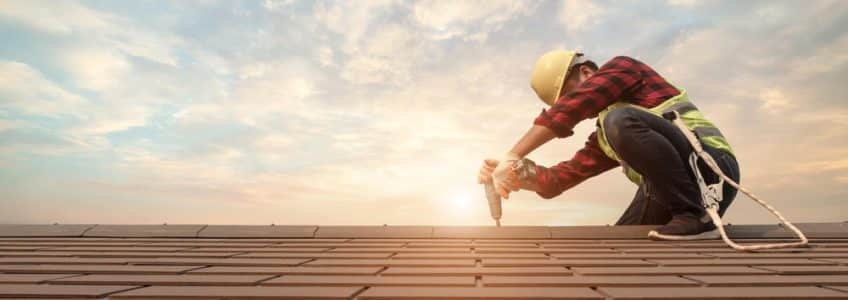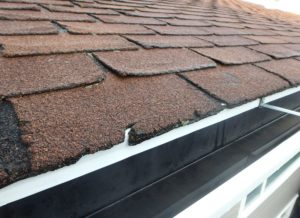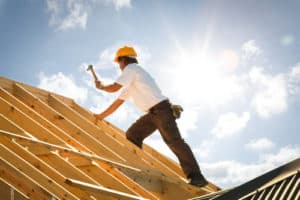
Increased sunlight and summer temperatures can damage your roof. High temperatures accelerate the breakdown of chemicals used in making roofs. As a result, your roof becomes more susceptible to damage. The heat also enters your home unless your roof is insulated.
Summer Heat Factors That Cause Roof Damage
Your roof suffers damage due to ultraviolet light, high moisture thermal shock, and high temperatures.
Ultraviolet Light
During summer, sunlight strikes your roof with the least atmospheric interference and causes damage even when it’s cloudy. Your roof also gets exposed to extra hours of light since summer days are prolonged. As a result, the rate at which your roof materials decay increases. Also, UV causes your shingles to peel and oils in your roof to dry out.
High Humidity
Humid air always creates condensation that collects underneath your shingles. As the water heats and cools, your roof develops cracks and splits. The water collection can also result in leaks, mold, and mildew growth.
Thermal Shock
Summer temperatures are high during the day but drop rapidly when the sun sets. The sudden flux in temperatures makes your roof expand and contract. As a result, the tension weakens your roof’s structural integrity and splits it up. The scenario is common with metal roofs, which warp out of shape and get gaps.
Extreme Heat
Your roof is more vulnerable to extreme heat damage if you don’t have nearby shades. Summer temperatures rise to as high as 81.1 % in some states. Exorbitant heat hastens chemical processes that instigate your roof to break down faster. Dark-colored roofs absorb more heat and are thus more vulnerable to extreme heat damage.
Signs of a Heat Damaged Roof
 Your roof can withstand years of summer heat before the need for a replacement arises. However, you can catch signs of thermal shock, humidity damage, and roof degradation with frequent inspections. Then, you can perform the necessary repairs and ventilation to reverse the damage before the only solution goes from repair to roof replacement. Telltale signs that your roof has suffered heat damage include:
Your roof can withstand years of summer heat before the need for a replacement arises. However, you can catch signs of thermal shock, humidity damage, and roof degradation with frequent inspections. Then, you can perform the necessary repairs and ventilation to reverse the damage before the only solution goes from repair to roof replacement. Telltale signs that your roof has suffered heat damage include:
Discolored Patches
Sun damage causes part of your roof to be considerably lighter or more worn than others. Excessive UV exposure also bleaches and weakens your roof’s structural integrity. The metal components of your roof also rust due to humidity and heat, developing brown stains.
Ceiling Stains
Some roof damage allows water and debris to seep into your roof’s interior layer. You can then notice water strains across your ceiling or streaks down your walls. The longer you ignore a leaky roof, the easier for your structures to get mold and other damage related to leaky roofs.
Shingle Debris
You may notice shingles granules around your home’s perimeter, especially if you have an asphalt roof. Shingle debris is evidence that your shingles have disintegrated. Other materials such as flashings and nails also weaken and crack due to high temperatures and then drop on the ground.
Curls
Shingles and panels curl to adjust to your home’s heating and cooling patterns. Unfortunately, curls leave your roof’s pockets susceptible to the development of leaks and cracks. Besides, the appearance is unsightly and reduces curb appeal.
Attic Ventilation and Insulation
Proper attic ventilation naturally lowers your roof’s temperature. For example, you could install exhaust and intake vents or ceiling fans to prevent trapped heat, moisture, and mold. In addition, attic insulation protects against heat fluctuations and prevents moisture retention.
Cracks and Splits
Excessive heat and temperature fluctuations cause sudden expansion and contraction of roof materials. Whereas a certain level of compaction is normal, prolonged exposure makes your roof components reach a breaking point. Besides, heat dries roof tiles and causes buckles and blisters.
Ways to Prevent Summer Heat Damages on Your Roof
You can neither prevent the summer heat nor get your roof out of the sun. So, the ideal way to keep your roof safe is to take the necessary protection measures. Below are several ways to guard your roof against summer heat damage.
Plant a Rooftop Garden
Rooftop gardens remove heat from the air to protect your roof from the sun. But, you’ll need a professional inspection to ensure your roof is structurally sound before you install a garden. Also, whenever you water the garden, take care not to cause any water damage to roof components.
Install Solar Panels
Solar panels would be perfect if you want a long-term, sustainable option to shield against the sun. These panels attract and absorb sunlight. They can cover a significant part of your roof and protect it against sun damage.
Use Reflective Gravel
With the addition of reflective gravel, a flat roof with raised edges is safer from sun damage. The gravel radiates heat away from your roof, keeping it cool. Nonetheless, your roof must have a rim or barrier at the exterior. Otherwise, your gravel will slide off with time.
Care for Your Roofing During the Summer
 Your roof lasts longer with the appropriate care and maintenance. In addition, you’ll need a professional inspection once in a while to spot problems that might escape your eye. Look no further than Advantage Construction Inc whenever you need any roof services. Contact our team today for more information.
Your roof lasts longer with the appropriate care and maintenance. In addition, you’ll need a professional inspection once in a while to spot problems that might escape your eye. Look no further than Advantage Construction Inc whenever you need any roof services. Contact our team today for more information.
